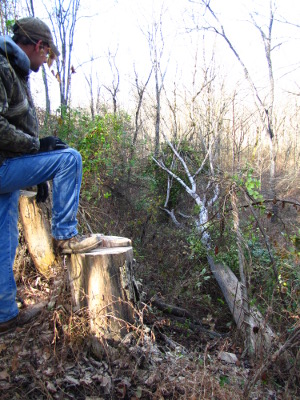
Standing snags are firewood insurance
 A
three-trunked, dead black locust used to stand just outside our core
homestead. One trunk fell
in spring 2009, and
another fell during the heavy snows the
following winter.
I'd left the remaining trunk as an insurance policy --- standing snags
are generally pretty dry and can be cut and used for firewood nearly
immediately. But I knew the wood couldn't stay good indefinitely.
A
three-trunked, dead black locust used to stand just outside our core
homestead. One trunk fell
in spring 2009, and
another fell during the heavy snows the
following winter.
I'd left the remaining trunk as an insurance policy --- standing snags
are generally pretty dry and can be cut and used for firewood nearly
immediately. But I knew the wood couldn't stay good indefinitely.
We didn't buy any wood
this year, opting instead to pay Bradley to come over and cut various
trees, one of which was the locust snag. I was amazed at how much
firewood that one tree created --- probably enough for a month of fires
--- and by how dry the wood was. I had originally planned to put
the locust in the shed for a month, but Bradley thought it could be
used right away, and he was correct. The splinters that came off
the extremely hard-to-split logs were top-notch kindling, and the logs
themselves felt drier than wood that had been sitting in the shed since
last year.
Now we've got lots of
piles of wood sitting around waiting to be ferried up to the wood
shed. A day and a half of Bradley's hard work probably created
enough wood for the rest of this winter and part of next, which makes
firewood-gathering look awfully easy until you realize he's been
brushing up on his chainsaw skills since he was eight.
Want more in-depth information? Browse through our books.
Or explore more posts by date or by subject.
About us: Anna Hess and Mark Hamilton spent over a decade living self-sufficiently in the mountains of Virginia before moving north to start over from scratch in the foothills of Ohio. They've experimented with permaculture, no-till gardening, trailersteading, home-based microbusinesses and much more, writing about their adventures in both blogs and books.
Want to be notified when new comments are posted on this page? Click on the RSS button after you add a comment to subscribe to the comment feed, or simply check the box beside "email replies to me" while writing your comment.
- Remove comment
- Remove comment
